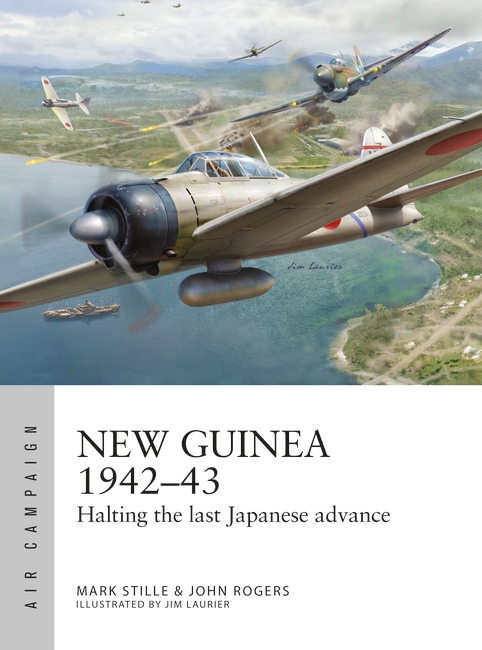
As its military campaigns in the Philippines and Dutch East Indies successfully concluded in early 1942, Japan turned its attention eastward. Japan’s goal in the South Pacific was to secure a defensive perimeter to resist future Allied attempts to reverse its conquests in the Indies and Southeast Asia. Two avenues of extending Japan’s control presented themselves. The first was to extend Japan’s reach to the southeast through the Solomons, New Caledonia, Fiji, and Samoa to seal off Australia from air and maritime support from the United States. The second was to seize Port Moresby, the only major settlement on Papuan New Guinea, to overawe Australia to sue for peace and bring Japanese air and naval forces into a better geographic position to support the first avenue of attack. Japan could use its major regional air and naval base complex in the vicinity of Rabaul on New Britain, approximately 900 miles north of Australia’s major northeastern air bases, to facilitate either or both of these options. Japan ultimately decided to undertake air and naval operations along both the New Guinea and Solomons axes simultaneously.
The initial Allied reaction to this situation was to prepare for a defense of Australia itself. The Australian Chiefs of Staff briefed MacArthur in March on a plan to cede much of northern and western Australia to the Japanese while defending a line running diagonally from Brisbane to Adelaide. However, MacArthur, as supreme Allied commander, chose to defend Australia in New Guinea with an eye to later pursuing an offensive strategy to retake the Philippines. The major problem the defenders had was the lack of forces - air, sea, and land – with which to check the Japanese advance.
Both attackers and defenders were subject to the same two complicating, and interrelated, situational factors: the distances and the environment of the battlespace. In the case of distances, there were few adequate air bases along either of Japan’s axes of effort, and without aircraft carriers available the Imperial Japanese Naval Air Force (IJNAF) was handicapped by the relatively short time its fighters, flying from Rabaul, could escort land-based bombers and engage Allied forces. New Guinea is the world’s second largest island after Greenland, and the great distances from Australian bases to Japanese targets there and around Rabaul likewise complicated Allied missions against most Japanese targets. As for the environment, both sides were negatively affected by the weather and the dense, often featureless jungle terrain. The region was susceptible to major fluctuations in cloud density and altitude, and tropical storm fronts formed quickly; sustained heavy rains were frequent. New Guinea’s terrain also presented a major obstacle. The Owen Stanley mountain range runs down the middle of Papua, where the campaign was fought during 1942 and into early 1943. The 9,000¬13,000 foot-high range often forced aircraft crossing the range to follow certain routes through lower-altitude gaps in the range or climb over the range and to use more fuel, often at the expense of smaller bomb and cargo loads. New Guinea’s jungles were virtually impenetrable and, along with shark-infested waters surrounding the island, limited the chances of survival of downed pilots as well as the practical locations for building new airfields to reduce distances.
The outcome of Japan’s New Guinea air campaign covered in this study was a profound disaster for Japan’s strategy, and for the IJNAF in particular. Japan’s defeat grew out of mistaken strategic and operational decisions, reinforcing failure, and misallocation of already inadequate resources. Strategically the Japanese took too long to implement their plans and misjudged the speed of the modest Allied defensive buildup. Operationally, the Japanese use of air power reflected, and suffered from, both unrealistic expectations and irresolute pursuit of them. Despite multiple waves of IJNAF bomber and fighter reinforcements moved into the theater during the campaign, Japan never mounted sustained, effective bombing attacks against Allied airfields. Nor did the IJNAF ever seriously undertake to choke off Port Moresby from receiving supplies from Australia by sea. The IJNAF also did not cooperate well with the Imperial Japanese Army nor with maritime transport activities generally, leading to the disasters of the Buna enclave and Battle of the Bismarck Sea.
As for the Allies, their strategy of holding on in New Guinea despite the lack of resources proved a successful gamble. They could simply win by not losing. The Allies understood that Rabaul was the Japanese center of gravity and their attacks, though often very limited, ultimately denied Japan the use of Rabaul as a fully secure area from which to launch offensive action. The doctrinal and tactical flexibility of the Allies also played a key role in turning the tide in the campaign in late 1942. The shift to medium- to low-altitude bombing and strafing and the development of “skip” bombing paid great dividends for the Allies. But the adroit use of air transport to improve the mobility and supply of land forces was probably the single most effective aspect of the Allied air effort. Finally, the Allies were able to provide, assemble, repair, and modify aircraft from the relative safety of Australian facilities. The Japanese were also able to replace aircraft by flying and shipping them between Japan and Rabaul but did not have the same level of repair and maintenance facilities as close to the action as the Allies had. In this sense the operational level “interior lines” factor favored the Allies.
You can read more in ACM 56 New Guinea 1942–43: Halting the last Japanese advance

Comments
You must be logged in to comment on this post. Click here to log in.
Submit your comment